Vintage Treasures: Poseidonis by Clark Ashton Smith
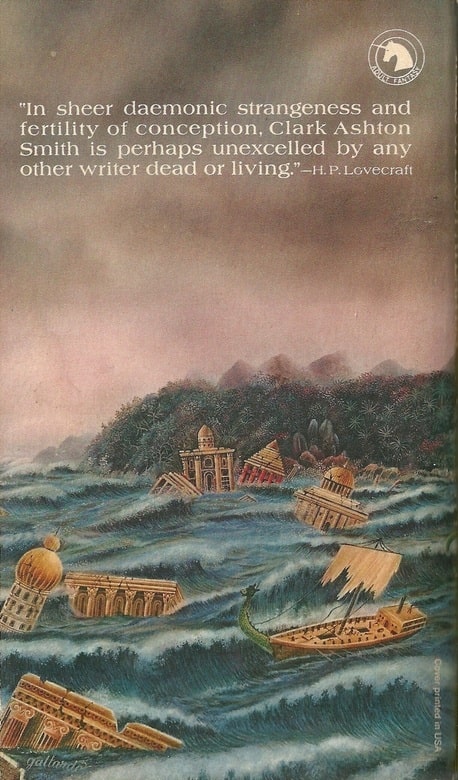 |
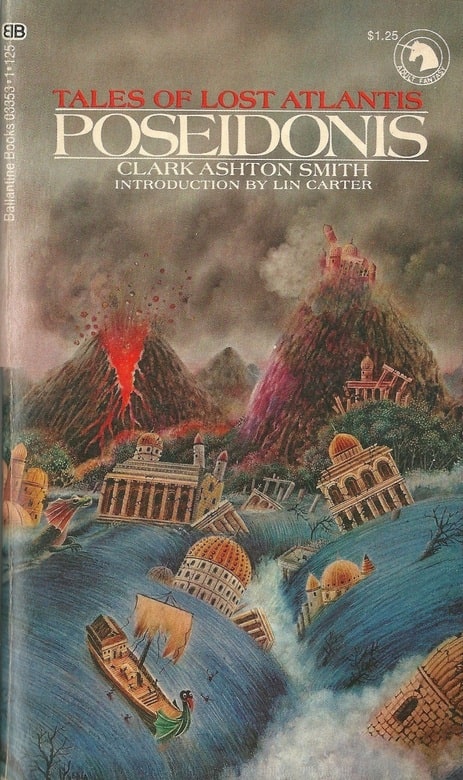 |
Poseidonis (Ballantine Adult Fantasy #59, July 1973). Cover by Gervasio Gallardo
I’ve been collecting Clark Ashton Smith recently, and I keep coming back to the wonderful Ballantine Adult Fantasy editions edited by Lin Carter in the early 70s.
It’s not nostalgia (well, maybe it’s a little nostalgia). And it’s certainly not that the stories aren’t available in other editions — Smith’s work has been annotated and collected by more than half a dozen publishers this century alone, including Night Shade, Penguin Classics, Hippocampus Press, Prime Books, Bison Books, Centipede Press, and others. It’s not even the great cover art — great as it is (and it’s pretty darn great), Smith has benefitted from some truly excellent cover art for most of his reissues.
What draws me to these editions is Lin Carter’s excellent commentary and editorials. When Carter was assembling these books in the early seventies most of Smith’s work was long out of print, available only in moldering pulp magazines (and a handful of expensive hardcovers from Arkham House), and Carter was introducing one of the greatest pulp writers of the 20th Century to an audience that was woefully unfamiliar with his work. He did a fabulous job of preparing readers for the wonders that awaited them.
[Click the images to sink below the waves with bigger versions.]
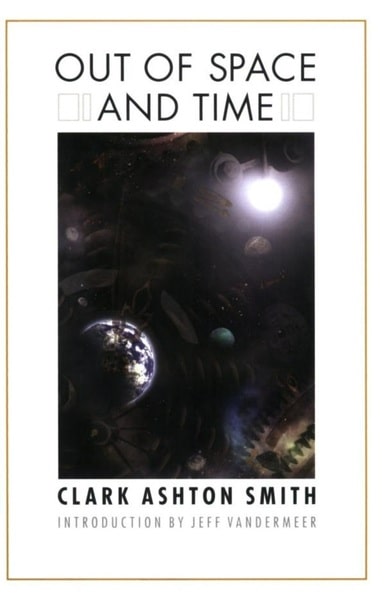 |
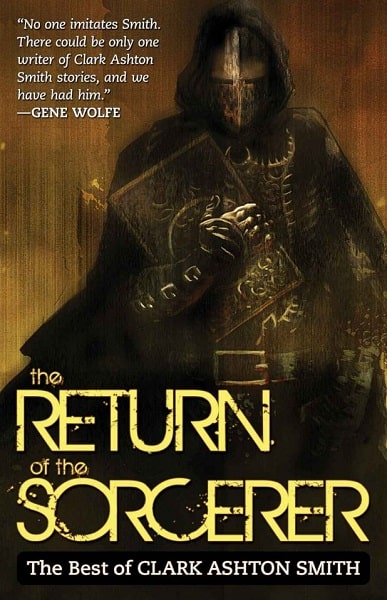 |
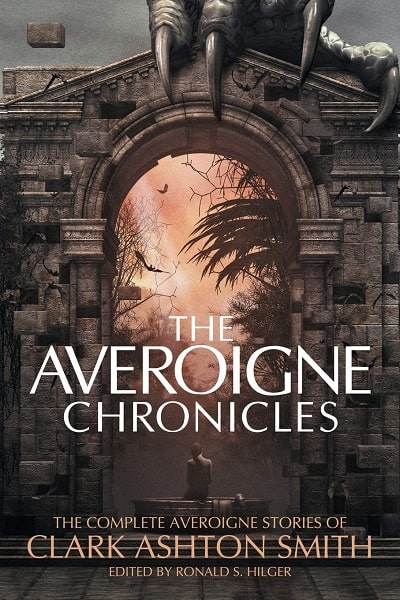 |
More recent Smith editions: Out of Space and Time (Bison Books, October 2006), The Return of the Sorcerer
(Prime Books, October 2009), and The Averoigne Chronicles: The Complete Averoigne Stories of Clark
Ashton Smith (Hippocampus Press, January 2021). Covers by Stasys Eidiejus, Peter Bergting, and David Ho
Lin Carter considered Clark Ashton Smith to be the greatest of the Weird Tales writers, and indeed, “one of the greatest fantasy geniuses of all literature.”
Here’s an excerpt from his introduction to Poseidonis, Smith’s collection of tales of lost Atlantis.
Of all the many writers who contributed to the Golden Age of Farnsworth Wright’s magazine Weird Tales, Clark Ashton Smith stands out as a clearly superior talent. To my own taste, he is far and away a better writer than his good friends and correspondents Robert E. Howard and H.P. Lovecraft. Howard’s stories have excitement and gusto and driving narrative force, but Howard was clumsy with coined names and his tales are grim and humorless. Lovecraft had great imaginative gifts, but he was unable to create viable characters or write credible dialogue, and completely unable to create women.
Their Californian colleague, however, shared few of their emotionally crippling hang-ups and could write rings around them both. Smith mastered a bedizened lapidary style that savors of Vathek and Salamnbi; he wrote with a lazy, mocking, sardonic humor that I find delicious; his tales are ornamented with exotic words and coined names as magical and evocative as the best of Dunsany’s. He seems to me not only the best of the Weird Tales writers, but one of the greatest fantasy geniuses of all literature, ranking not far beneath Eddison and Dunsany.
What is most incredible of all is that his entire fantasy reputation rest on slightly more than one hundred short stories. almost all of which he wrote between 1929 and 1935. In that brief span of only six year he created a series of masterworks that are among the most precious jewels of weird fantasy we possess… [he] added new richness and luster to the legend of Atlantis, whose dark and virile magic continues to enthrall the imagination.
Poseidonis contains all of Smith’s tales of Atlantis, including three Poseidonis tales and two poems, plus two stories in his Malygris sequence, featuring the dark sorcerer Malygris, who abides in “his tower that was builded on a conical hill above the heart of Susran, capital of Poseidonis.”
Inside cover of Poseidonis
Gilbert Stack has a fine one-paragraph review of the audio version of the short story “The Death of Malygris,” included in Poseidonis.
One of the things that stands out about Clark Ashton Smith’s short stories is that there are often no good guys to be found in the pages. In this excellent story, a great necromancer has died — or has he? As other magical powers seek to confirm Malygris’ demise and to profit from it, they continue to run afoul of his nefarious preparations to punish people who try to do precisely that. This is a story about watching bad things happen to bad people. On its own, it’s quite creepy, but with William L. Hahn’s narrative talents, it is far more insidious than that — so much so that you’ll be looking twice next time you drive past a cemetery.
But the person who’s done the best scholarship on these stories is, in my opinion, Ryan Harvey, who explored Smith’s work in a series of superb articles for Black Gate over a decade ago. Here’s his introduction to Part IV of the series, Poseidonis, Mars, And Xiccarph, from 2007.
The lands of Averoigne, Hyperborea, and Zothique comprise the bulk of the Northern Californian author’s fantasy stories, but a few “mini-cycles” of two to five tales each also emerged during his most active period of fiction-writing in the early 1930s. Smith may have planned to expand these series into full cycles large enough for book publication, as he attempted with Zothique and Hyperborea. Internal references in this handful of tales, such as the recurring figure of Malygris in the Poseidonis stories and Maal Dweb in both Xiccarph chronicles, indicate that their creator was attempting to weave a unified backdrop for further works — except that the later works never emerged.
The three most important mini-cycles occur on a remnant of sinking Atlantis called Poseidonis, a human-colonized Mars containing ancient horrors from its primordial past, and the mysterious planet of Xiccarph. The Poseidonis stories resemble the style of the Zothique cycle in their doomed terrestrial environment. The other two mini-cycles take place in interplanetary settings that would normally fall under the aegis of science fiction. Smith did pen a number of straight science-fiction works like “The Master of the Asteroid” and “An Adventure in Futurity,” but the tales of Mars and Xiccarph have more in common with dark fantasy than the space opera of the early 1930s. Smith’s adept melding of science fiction, fantasy, and horror in these two planetary settings offers a fascinating view of his genre-blurring style.
Here’s Ryan on one of the more famous stories in the collection, “The Double Shadow.”
The events of this story, one of Smith’s finest, occur two generations after the wizard Malygris ruled Susran with his necromantic terror. Malygris’s final surviving pupil, Avyctes, has withdrawn from the world to content himself with scholarly studies in a marble mansion above the sea. His own student, Pharpetron, narrates the tale of the fate that befalls them when they unlock the magical secrets of a tablet of the extinct serpent-men that washes ashore near the mansion. After unraveling the cipher on the tablet, the two sorcerers use it to cast a summoning spell. The invocation appears to fail, but a few days later Pharpetron notices a second shadow tailing behind his master’s own: “its form was altogether monstrous, having a squat head and a long undulant body, without similitude to beast or devil.” Worse, the new shadow seems to creep closer to Avyctes’ real shadow with each day.
The power of the “The Double Shadow” comes from its clever magical curse that creates a tangible creeping doom and its excellent word-wizardry that shows the author doing what he does best: weaving literary magic with a perfectly selected choice of weird words. In lesser works, Smith could go over the top with his heapings of obscure diction, acting like someone flaunting his knowledge “Thesaurophical” (if you pardon me inventing a word). But when his muse was at its strongest and most inspired, he could create a work like “The Double Shadow,” which ensnares readers in otherworldliness from its opening and then sustains it without ostentatious distraction.
Although it does not directly deal with the fall of Poseidonis, the imagery of a “ravening” and destructive sea is potent in “The Double Shadow.” The writing keeps readers constantly reminded that Avyctes’ mansion lies perched over turbulent waters, and this instability heightens the tension and keeps the doom of Poseidonis at the forefront of a story of personal doom.
Read Ryan’s thoughts on the entire story cycle here.
All four Clark Ashton Smith collections published by Lin Carter for Ballantine
Adult Fantasy: Zothique, Hyperborea, Xiccarph, and Poseidonis (1970 – 1973).
Covers by George Barr, Bill Martin, Gervasio Gallardo, and Gervasio Gallardo
Lin Carter published four collections of Clark Ashton Smith’s fantasy as part of the Ballantine Adult Fantasy library:
Zothique (286 pages, $0.95 in paperback, June 1970) — cover by George Barr
Hyperborea (221 pages, $0.95 in paperback, April 1971) — cover by Bill Martin
Xiccarph (247 pages, $1.25 in paperback, February 1972) — cover by Gervasio Gallardo
Poseidonis (210 pages, $1.25 in paperback, July 1973) — cover by Gervasio Gallardo
Like many of Clark’s older editions, prices for these paperbacks have been steadily creeping upwards. They hovered around ten bucks each for much of the last decade, but they average two to three times that today, and good condition copies of Zothique — the hardest to come by these days — will run you $40-80.
Here’s the complete TOC for the Ballantine edition of Poseidonis, including Carter’s essays scattered through the text.
The Magic of Atlantis, by Lin Carter
An Editor’s Note, by Lin Carter
The Muse of Atlantis — poem
“The Last Incantation” (Weird Tales, June 1930)
“The Death of Malygris” (Weird Tales, April 1934)
Tolometh (1958) — poem
“The Double Shadow” (The Double Shadow and Other Fantasies, 1933)
“A Voyage to Sfanomoë” (Weird Tales, August 1931)
“A Vintage from Atlantis” (Weird Tales, September 1933)
Atlantis (1912) — poem
Editor’s Note 2, by Lin Carter
In Lemuria (1921) — poem
“An Offering to the Moon” (Weird Tales, September 1953)
“The Uncharted Isle” (Weird Tales, November 1930)
Lemurienne (1971) — poem
Editor’s Note 3, by Lin Carter
“The Epiphany of Death” (The Fantasy Fan, July 1934)
Editor’s Note 4, by Lin Carter
In Cocaigne (1922) — poem
“Symposium of the Gorgon” (Fantastic Universe, October 1958)
“The Venus of Azombeii” (Weird Tales, June-July 1931)
The Isle of Saturn (1951) — poem
“The Root of Ampoi” (The Arkham Sampler, Spring 1949)
“The Invisible City” (Wonder Stories, June 1932)
Amithaine (1951) — poem
“The Willow Landscape” (The Philippine Magazine, May 1931)
The Shadows (1922) – poem
It’s possible we’ve written more about Clark Ashton Smith at Black Gate than any other writers except Tolkien, Robert E. Howard, and H.P. Lovecraft. Our previous coverage includes:
Vintage Treasures: The City of the Singing Flame by Clark Ashton Smith
The Ordinary is Ephemeral: Robert E. Howard, Clark Ashton Smith, H.P. Lovecraft, and the Battle Against Modernism, by David C. Smith
Adventure and Tragedy on a Far Future Earth: Keith West on Zothique by Clark Ashton Smith
Literary Wonder & Adventure Podcast: Clark Ashton Smith, Poet of the Fantastic
Birthday Reviews: Clark Ashton Smith’s “The Maze of Maal Dweb” by Steven H Silver
Starfinder Alien Archive — Clark Ashton Smith Meets Douglas Adams (With Visuals by Ray Harryhausen) by M Harold Page
A Jaunt Through Clark Ashton Smith’s Collected Fantasies — Vol. 1: The End of the Story, by Ryan Harvey
A Jaunt Through Clark Ashton Smith’s Collected Fantasies — Vol. 2: The Door to Saturn, by Ryan Harvey
A Jaunt Through Clark Ashton Smith’s Collected Fantasies—vol. 3: A Vintage from Atlantis, by Ryan Harvey
The End Of The Story: The Collected Fantasies, Vol. 1 by Clark Ashton Smith
Vintage Treasures: The Timescape Clark Ashton Smith
The Shade of Klarkash-Ton by James Maliszewski
One Shot, One Story: Clark Ashton Smith by Thomas Parker
New Treasures: The Dark Eidolon and Other Fantasies by Clark Ashton Smith
The Crawling Horrors of Mars: Clark Ashton Smith’s “The Vaults of Yoh-Vombis”
Deepest, Darkest Eden edited by Cody Goodfellow by Fletcher Vredenburgh
Adventures in Stealth Publishing: The Return of the Sorcerer
A Few Words on Clark Ashton Smith by Matthew David Surridge
The Unqualified Unique: The Daily Mail Interviews Me for Clark Ashton Smith’s 50th Morbid Anniversary by Ryan Harvey
Of Secret Worlds Incredible: A Psychedelic Journey into Clark Ashton Smith’s Poetic Masterpiece by John R. Fultz
The Fantasy Cycles of Clark Ashton Smith Part I: The Averoigne Chronicles by Ryan Harvey
The Fantasy Cycles of Clark Ashton Smith Part II: The Book of Hyperborea by Ryan Harvey
The Fantasy Cycles of Clark Ashton Smith Part III: Tales of Zothique by Ryan Harvey
The Fantasy Cycles of Clark Ashton Smith Part IV: Poseidonis, Mars, and Xiccarph by Ryan Harvey
The Return of the Sorcerer: Falling Under Clark Ashton Smith’s Potent Spell for the First Time by Brian Murphy
See all our recent Vintage Treasures here.
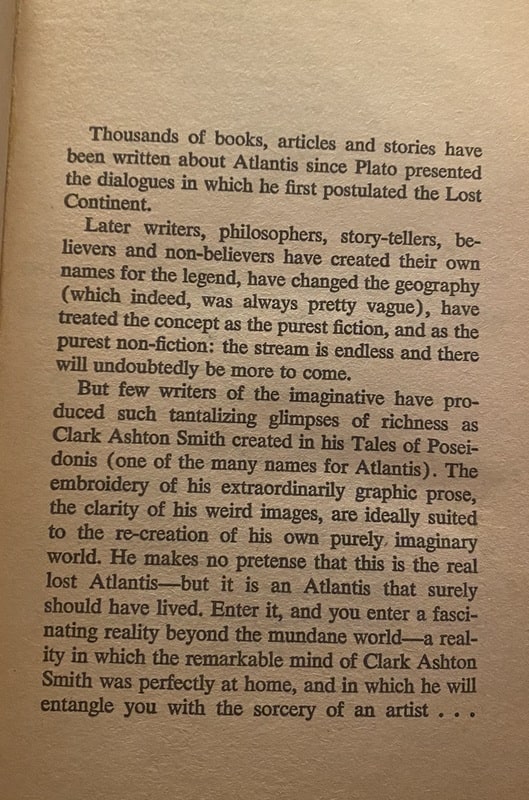
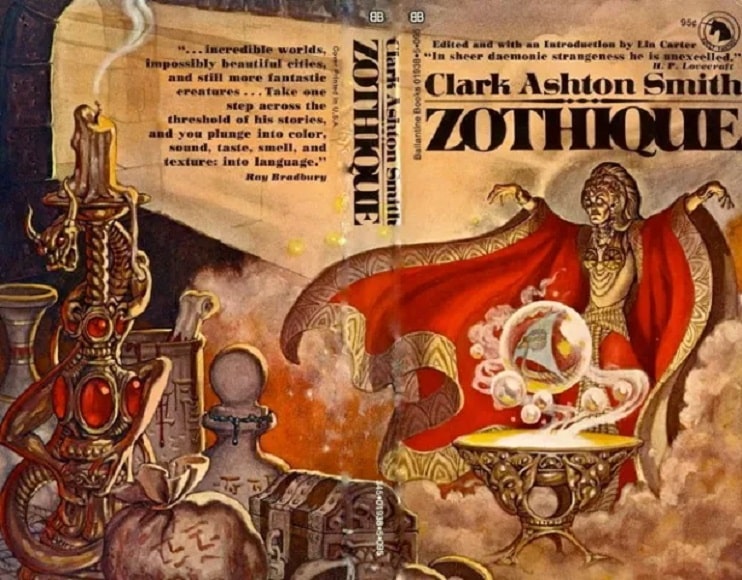
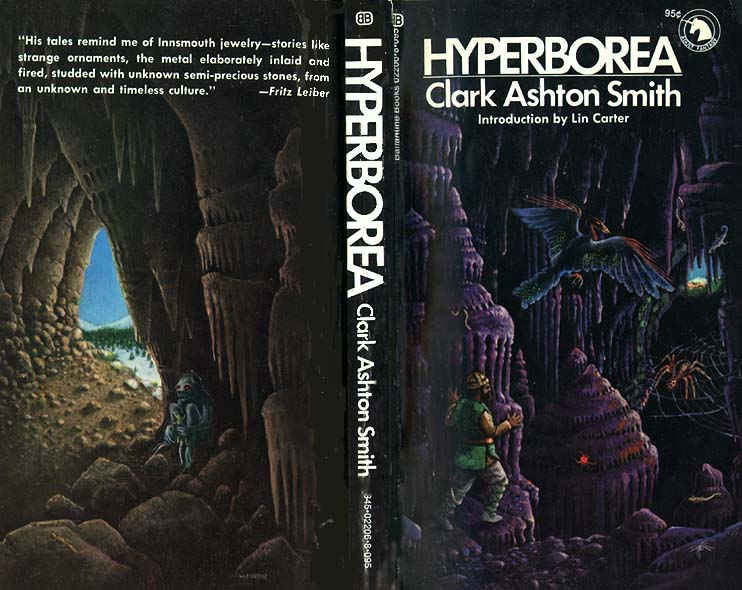
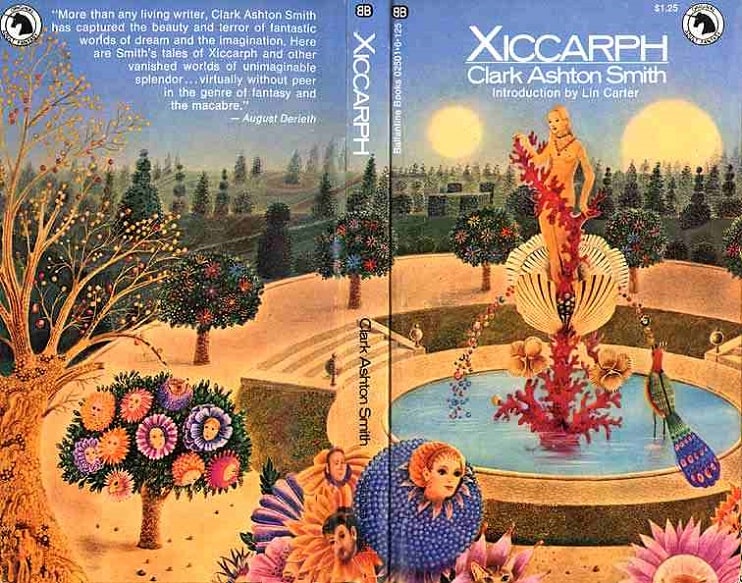
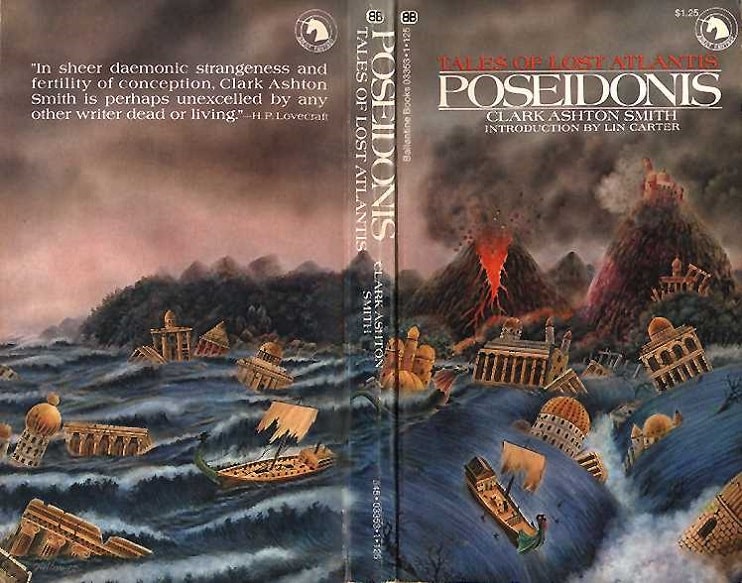
I have the BAF Poseidonis and Zothique, but not the other two. I’m always looking, but I think the four Smiths are the priciest BAFs of all.
Zothique and Hyperborea seem like the most expensive, but I’m still on the hunt for a good condition copy of Xiccarph.
I’m gonna try to beat you to it!
If I remember rightly, Michael Moorcock seconded Carter and said that Smith was his favorite of the Weird Tales “big three.” I’m so glad they’re perceptive enough to agree with me!
I didn’t know that! Do you have a source for that?
In his study of epic fantasy, Wizardry & Wild Romance, Moorcock does praise Smith:
“His prose contains a vitality rarely apparent in this kind of fiction, and there is frequently a strong vein of irony, which was to mark the work of a later writer, Fritz Leiber. In Smith, intelligence and a genuine love of language, an almost playful relish for the exotic, a carelessness of spirit, in great contrast to the obsessive aggression of Lovecraft, make his work more palatable to me.” (56)
He then compares Smith to Howard:
“Smith was able to combine rapid action with his descriptions, as Stevenson often did, his landscapes actually contributing to his story’s dynamic. In this, he had something in common with Robert E. Howard, another reclusive young man who wrote at an enormous rate for a few years …” (57)
Fantastic Eugene! Thanks for tracking that down. I should have guessed you’d be the one to have a reference handy. 🙂
This just reminds me that I still don’t have a copy of Wizardry and Wild Romance, and that’s a crime.
I’m not sure, John. I have Wizardry and Wild Romance, and I’m pretty sure it wasn’t in there. (My understanding is that, despite Moorcock’s name being on the cover, Wizardry is mostly the work of James Cawthorne anyway.) Likely it was in an introduction or preface to something or other. That’s the best my fast-fading brain can do at the moment!
I’m a big CAS fan, as regulars on Blackgate will know, and found out about him thanks to Lin Carter’s inclusion of The Maze of Maal Dweb in The Young Magicians. I bought any CAS books I could find after that. You can read the stories online (all of them, to the best of my knowledge) on Eldritch Dark.* I re-read a number a few years ago, including The Double-Shadow (and yes, the setting is great and is vividly described in CAS’s unique fashion).
A small number of ‘pulp’ authors survived the test of time because their work was way better than the genre demanded. They were authors who took a pride in their craft. Howard is one example. CAS is another.
* the site has also posted up some of the book covers.
http://www.eldritchdark.com/galleries/books-of-cas/all/a/10
I had both books in the Lost Worlds sequence.
Aonghus,
That’s a great link! I have bookmarked it as a wonderful CAS resource. The online stories are great, but it’s the huge catalog of CAS book and magazine covers that really entranced me. 🙂
Eldritch Dark is THE site for all things CAS-related!
The two Lost World’s are the only CAS I own. The Panther imprints. Both were lucky finds. I would love to lay my hands on the Ballantine books.
And in related news, William Morris and Ballantine Adult Fantasy were covered in brief near a decade ago, here: https://www.blackgate.com/2014/03/03/the-ballantine-adult-fantasy-series-the-wood-beyond-the-world-by-william-morris/
Thanks Tony! That’s one of Keith West’s excellent pieces on the timeless Ballantine Adult Fantasy volumes.
Keith and I have been talking about having him pick up his unfinished article series on Ballantine Adult Fantasy, and I hope we can welcome him back here soon. Keep your fingers crossed!
I don’t know if CAS was the best writer in the Weird Tales. Robert E. Howard had more of the natural storyteller gift and H.P. Lovecraft was more influential. However, CAS was definitely the best prose stylist of the three. Along with the likes of Jack Vance and Raymond Chandler, he was proof you could be both a pulp writer and a great prose stylist.
Matthew,
Yeah, I’m not sure I’d agree with Carter than CAS is head and shoulders above REH and HPL. If I had to choose, I’d probably choose Lovecraft myself. But I can definitely see an argument being made for each.
[…] “It’s not nostalgia (well, maybe it’s a little nostalgia). And it’s certainly not that the stories aren’t available in other editions — Smith’s work has been annotated and collected by more than half a dozen publishers this century alone, including Night Shade, Penguin Classics, Hippocampus Press, Prime Books, Bison Books, Centipede Press, and others. It’s not even the great cover art — great as it is (and it’s pretty darn great), Smith has benefitted from some truly excellent cover art for most of his reissues. What draws me to these editions is Lin Carter’s excellent commentary and editorials. When Carter was assembling these books in the early seventies most of Smith’s work was long out of print, available only in moldering pulp magazines (and a handful of expensive hardcovers from Arkham House), and Carter was introducing one of the greatest pulp writers of the 20th Century to an audience that was woefully unfamiliar with his work. He did a fabulous job of preparing readers for the wonders that awaited them.”—Vintage Treasures: Poseidonis by Clark Ashton Smith […]
Hyperborea and Poseidonis (I _think_ in that order) were the first BAF CAS that I owned, although I believer that was after I had already read City of the Singing Flame, his Pocket Timescape collection with the wonderful Rowena cover.
I do have all for BAF CASes (and all other BAFs) now.
(Near as I can figure, sometime in the early 1980s, somebody in my small, southern MN hometown offloaded a whole bunch of BAF books, including the CAS volumes, several of the Carter anthologies, and a few others, the specifics of which I can’t recall, to the local used bookstore, and although I had no idea what the BAF was at the time, I started snaffling them up based first on recognizing the author, and then on recognizing the style of cover art &c. as indicating, “Hey, this right here is probably pretty cool!”)
Joe,
Wow! That’s a great tale. Wonderful that all those amazing books went to an appreciative reader. 🙂
And if you’re going to discover the Ballantine Adult Fantasy line, Hyperborea and Poseidonis are probably the ways to do it (or maybe The Dream Quest of Unknown Kadath, or The Queen of Elfland’s Daughter…. heh. Maybe there’s no wrong way to do it).
Love that Gervasio Gallardo cover. He did quite a few of the Ballantine range. I quick search reveals so many beautiful paintings. Not sure if surreal is the correct term?
A little OT but now having scrolled past a few beautiful covers, I have to go and read up on William Morris – The Water of the Wondrous Isles.
Tony,
That’s the thing about the BAF editions. They have such wonderful consistency of quality, design, and gorgeous art that they make an enormously inviting whole. If you’re familiar with even one, you can’t look at any of them without an element of wonder.
They were designed as a gateway into fantasy for readers of all ages, and that gate has remained open — and powerfully inviting — for generations. It may be Lin Carter’s greatest achievement.
So true John. I only own one (Merlins Ring) but would love to own and enjoy the whole range. One cas just feel the love and passion for the genre coming through.
I’ve been on the road having to deal with family situations and missed this post when it went up. I’m glad CAS and the Adult Fantasy line are getting some love.
My schedule may loosen up later in the year, depending on how some major career/life changes go and I’m hoping to get back to reading my way through the BAF series. If that works out, John, I’d be interested in reviving my posts on that series if you’re open to that.
Keith,
Sorry to hear about your family drama. But we’d LOVE to have you pick up your review series on the Ballantine Adult Fantasy series — that would be epic.
I’ll send you an email.
OH, indeed I agree that CAS was the best writer – likely of Weird Tales total…
REH was epic also in his own way – more from being such an obsessed dreamer he lived in his mind his tales and hacked through like his barbarian heroes. HPL was more intellectual than REH though had various failings, more his insular shyness but he added that to his works. But CAS had mastered the language and form in ways not seen until the likes of Burroughs. He also broke all the molds – lived alone but was social, did stories but also ok art and wonderful sculpture and good poetry. I wouldn’t be surprised if he didn’t also play a musical instrument or three and knew several languages fluently. IMO of that era only Lord Dunsany was truly a better writer and master of language. Sometimes I’ve wondered what if CAS met Dunsany vs Lovecraft – they might have started a correspondence like Dunsany also had with Arthur C. Clarke. I wonder the effects on the stories…?
Of this world my favorite is “The Death of Malgyris” – I’m not going to argue “Best!” and why, just saying it is my favorite. I’ve even named a character in some of my stories set in a similar era a similar name to imply he might be that Wizard when Atlantis at last faces its doom. I like Zothique of these worlds best, then Hyperborea – but these are all so good.
One thing that I didn’t really notice at first, but which I find interesting is the way that each of Smith’s settings has its own mood. Hyperborea seems more tongue in cheek, Zothique is decadent and perverse, and the Poseidonis stories have a definite air of melancholy about them. (It’s harder to say anything definite about Xiccarph given that Smith only wrote the two stories about it, both about the same wizard.)
Joe,
That’s an astute observation. You’re absolutely right — I can’t look at the Poseidonis, for example, without experiencing the same sort of melancholy and loss that I feel when I think about the Library of Alexandria. Bill Martin’s cover for Hyperborea speaks to me of colorful adventure in the same way that The Arabian Nights does. But my favorite is George Barr’s cover for Zothique which, just as you said, hints at tales decadent and perverse.
It’s a tour de force of Art Direction. One more reason the BAF editions are considered modern masterpieces.
How did I miss all the CAS coverage in Black Gate?
I agree that CAS is a great writer, and in some ways better than HPL or REH–with the caveat of I think CAS is better in the short form… like an extremely rich dessert, it is easy to have too much.
I’ve got the Zothique cycle and have read or listened to all his other stories.
I also think he does some slight of hand with his language to hide the fact that often not that much really happens in his stories–not necessarily a bad thing, but something that I noticed.
He really knows how to bring the sorcery into Sword and Sorcery, often having his main characters actually be sorcerers. That said, while he almost always gets off to a great start, he sometimes doesn’t quite stick the landing. For all their knowledge and power, his sorcerers often find themselves utterly helpless before the situations they encounter–not even attempting anything to save themselves. But again, his use of language is so sharp that it often slips past you.
Joe H., I agree that CAS does seem to have a different ‘mood’ in each of his settings. But in my last read of his ‘Hyperborea’ I couldn’t help getting a bit of a…sour note? Like he’s trying to take the piss out of HPL’s cosmic horror and REHs action S&S with tongue-in-cheek/nearly-parody tone. Of course, two of his best stories “The Tale of Satampra Zeiros” and “The Theft of the Thirty-Nine Girdles” are two of my favorites.
One other thing that I think CAS does (and maybe he planned this, maybe he didn’t) is that he has very few re-occurring characters– so each story you don’t know if the main character is going to make it or not– excitement!
Adrian,
I never considered Smith’s preference for non-recurring characters as a strength… but now that you point it out, I think you’re absolutely right. I can’t start a CAS tale of dark sorcery without a certain smug certainty that the sorcerer isn’t going to make it whole and intact all the way to the end!
I have to say, your comments above are insightful and right on point, at least from my (decidedly non-expert) viewpoint. Tell me how I can lure you into adding to our growing lore on CAS at Black Gate!
I slowly collected the whole Ballantine adult fantasy line when Keith West was doing his posts on the series a few years ago. I don’t remember the CAS volumes being that hard to find or that expensive. The only volume that did fit that bill then was the G. K. Chesterton *The Man Who Was Thursday.* If memory serves, I think that volume set me back over $70 or so. Most of the volumes cost me $5-15 (with postage back then). The Chesterton one was the hard one to find, at least about ten years ago.
James,
First of all, I deeply envy your complete BAF collection! I’m well short of that lofty goal, and I need to find much better copies of several of my battered copies.
And you are entirely correct that G. K. Chesterton’s The Man Who Was Thursday is the holy grail of the set. I don’t have a copy, and I’m pretty sure I’ve never even seen one. Copies on eBay range from $38.95 all the way up to $200.
However, rare as it is, I don’t believe The Man Who Was Thursday has increased much in value over the last decade. Chesterton has slipped deeper into obscurity in the 21 Century. Clark Ashton Smith, on the other hand, remains widely in print and — if anything — is more talked about than ever. I don’t recall his BAF editions being particularly expensive 10 years ago. And that has most definitely changed.